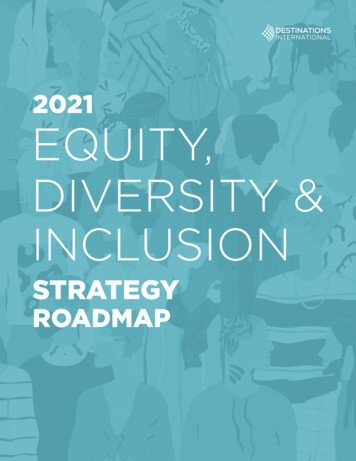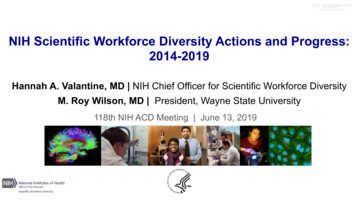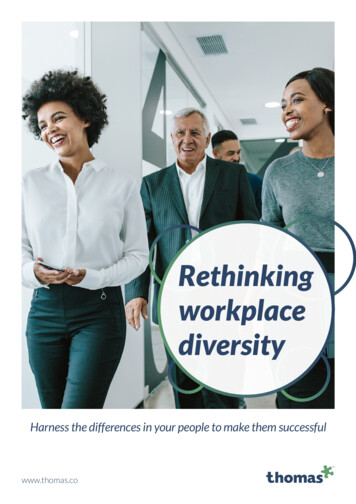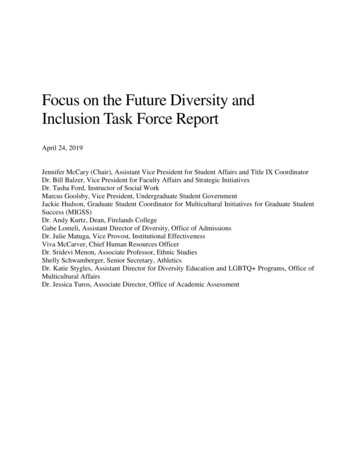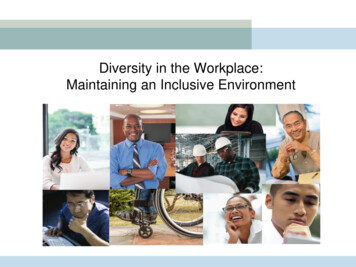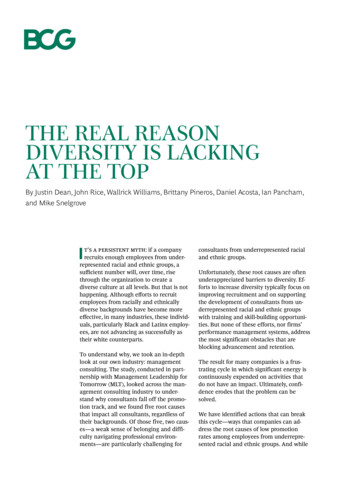
Transcription
THE REAL REASONDIVERSITY IS LACKINGAT THE TOPBy Justin Dean, John Rice, Wallrick Williams, Brittany Pineros, Daniel Acosta, Ian Pancham,and Mike SnelgroveIt’s a persistent myth: if a companyrecruits enough employees from underrepresented racial and ethnic groups, asufficient number will, over time, risethrough the organization to create adiverse culture at all levels. But that is nothappening. Although efforts to recruitemployees from racially and ethnicallydiverse backgrounds have become moreeffective, in many industries, these individuals, particularly Black and Latinx employees, are not advancing as successfully astheir white counterparts.To understand why, we took an in-depthlook at our own industry: managementconsulting. The study, conducted in partnership with Management Leadership forTomorrow (MLT), looked across the management consulting industry to understand why consultants fall off the promotion track, and we found five root causesthat impact all consultants, regardless oftheir backgrounds. Of those five, two causes—a weak sense of belonging and difficulty navigating professional environments—are particularly challenging forconsultants from underrepresented racialand ethnic groups.Unfortunately, these root causes are oftenunderappreciated barriers to diversity. Efforts to increase diversity typically focus onimproving recruitment and on supportingthe development of consultants from underrepresented racial and ethnic groupswith training and skill-building opportunities. But none of these efforts, nor firms’performance management systems, addressthe most significant obstacles that areblocking advancement and retention.The result for many companies is a frustrating cycle in which significant energy iscontinuously expended on activities thatdo not have an impact. Ultimately, confidence erodes that the problem can besolved.We have identified actions that can breakthis cycle—ways that companies can address the root causes of low promotionrates among employees from underrepresented racial and ethnic groups. And while
our study focused on management consulting, the lessons learned are also relevantfor other industries, including banking andtechnology, that have faced challenges increating diversity and inclusion in the leadership ranks.The Power of DiversityThe renewed focus on racial inequity, particularly in the US, has reinforced the commitment among many business leaders topromote diversity in the workplace. Butthere is also a practical reason for companies to support greater diversity: it improves financial performance. In a 2018study, BCG found that companies withmanagement teams with above-average diversity reported higher innovation revenue.For those companies, sales from productsor services launched within the past threeyears was 19 percentage points above thatof companies with below-average leadership diversity.Unfortunately, statistics show that businessleadership is not growing more diverse, especially at the most senior levels; rather,the percentages of leaders from underrepresented racial and ethnic groups havehardly changed. In 2018, for example, Blackmanagers represented only 3.3% of seniormanagement in the US, down slightly from3.6% in 2007. Interestingly, the percentageof Black midlevel managers in the US hasbeen higher than the percentage of Blacksenior managers, but it increased onlyslightly, from 7.3% in 2007 to 7.5% in 2018.(See Exhibit 1.)This data suggests not only that the percentage of Black leaders has stagnated butalso that Black professionals are plateauingin middle management and not rising tothe most senior ranks. Some industries areparticularly lacking in diversity at the top:Black executives hold only 3% of seniormanagement positions in finance and insurance and 2% in the IT industry.One consequence of a lack of diversity isthat top management often doesn’t have aclear understanding of the obstacles and,therefore, deploys ineffective solutions. A2018 BCG study found that 33% of US employees who are from racially and ethnically diverse backgrounds see significant barriers to diversity when it comes toadvancement. Only 19% of white heterosexual men aged 45 and older, a group thataccounts for a large share of top leadershippositions, had that same view.Drilling Down on the BarriersThe field of management consulting facesmany of the same diversity challenges thatother highly competitive industries con-Exhibit 1 Business Leadership in the US Is Not Growing More DiverseBlack managers (%)107.3%7.5%3.6%3.3%0Middle managementSenior management20072018Source: U.S. Equal Employment Opportunity Commission.Boston Consulting Group The Real Reason Diversity Is Lacking at the Top 2
PUTTING CONSULTING UNDER THE MICROSCOPEManagement consultants are accustomed to coming into a company andquickly diagnosing the issues limitingperformance. In this case, BCG andManagement Leadership for Tomorrow(MLT), which prepares college andbusiness school graduates from underrepresented groups to achieve in theprivate and public sectors, turned thetables. We examined a sample of ten topcompanies in the consulting industry tounderstand what is blocking the promotion pathway for consultants fromracially and ethnically diverse backgrounds.We conducted 25 interviews with currentand former consultants, managers, andpartners from ten firms, and MLTsurveyed more than 50 alumni who arecurrent or former employees of thosefirms. The interviews and survey explored the types of challenges faced bythese consultants, the level of supportfront. Although there has been a concertedeffort to improve diversity through recruitment as the industry has grown, our interviews found a consensus that the numberof partners from underrepresented racialand ethnic groups has not grown in proportion to the number of employees.Given that the first promotion is particularly critical, often signaling whether an individual has the skills to rise in the organization, we focused on identifying the challenges that have impeded the early progress of consultants from racially and ethnically diverse backgrounds. (See the sidebar“Putting Consulting Under the Microscope.”)Eight Limiting Challenges. An obviousquestion is whether the advancement gapcan be explained by differences in thelevels of skills and expertise among individuals when they are hired. To addressthis, we took a looked the key metrics forstudents graduating from the top 20 MBAprograms in the US in 2019. We comparedoffered, and the efficacy of that supportin addressing their challenges.The data gathered from the interviewsand survey were used to generate acomprehensive set of observablechallenges and to determine their rootcauses. We relentlessly compared ourfindings with those from the latestacademic research and collaborated withleading researchers in diversity to betterunderstand these challenges and theirroot causes.We then tested several hypotheses toidentify which root causes may explainthe low promotion rate among consultants from underrepresented racial andethnic groups in the industry, comparedwith the rate for those who are not fromunderrepresented groups. Finally, weidentified a set of evidence-basedinterventions to effectively address theroot causes.the qualifications with those of businessschool graduates who earned their MBAsin 2015, 2016, and 2017, participated inMLT’s Professional Development programfor underrepresented groups, and thenwere hired by top consulting firms. The twogroups served as proxies for our analysis:the former reflects typical entry-levelconsultants at top-tier firms, and the latterrepresents new consulting hires fromunderrepresented racial and ethnic groups.The result? The profiles for the two groupsare similar: when hired, those from raciallyand ethnically diverse backgrounds hadachieved the same level of academic excellence and had comparable work experience as those from the top 20 MBA programs that generally make up the universeof new recruits. (See Exhibit 2.)So, if the starting points are the same, whyare consultants from underrepresented racial and ethnic groups less successful atlanding promotions? From our interviewsBoston Consulting Group The Real Reason Diversity Is Lacking at the Top 3
Exhibit 2 The Typical Profiles of Entry-Level ConsultantsAcademicbackgroundPrior workexperienceGraduates of the top 20 MBAprograms, 20191Graduates of MBA programs whoparticipated in the MLT program,2015–20172Undergraduate major38% Business or economics30% Science, technology, engineering,and mathematics31% Social sciences or humanities44% Business or economics29% Science, technology, engineering,and mathematics27% Social sciences or humanitiesUndergraduate GPA3.17–3.86 (mid-80%3)3.00–3.80 (mid-80%4)MBA program100% Top 20 programs90% Fellows in one of the top 15 MBAprogramsScore on GMAT663–755 (mid-80%5)630–740 (mid-80%)Industries44% Consulting or finance12% Military, nonprofit, and government44% Other47% Consulting or finance17% Military, nonprofit, and government36% OtherSource: BCG analysis.Note: MLT Management Leadership for Tomorrow; GPA grade point average; GMAT graduate management admission test.1Class of 2019: Columbia Business School; Duke University’s Fuqua School of Business; Emory University’s Goizueta Business School; HaasSchool of Business, University of California, Berkeley; Harvard Business School; Kellogg School of Management Northwestern University;McCombs School of Business, The University of Texas at Austin; MIT Sloan School of Management; New York University Leonard N. SternSchool of Business; Samuel Curtis Johnson Graduate School of Management; Stanford Graduate School of Business; Stephen M. Ross Schoolof Business, University of Michigan; Tepper School of Business, Carnegie Mellon University; Tuck School of Business at Dartmouth; UCLAAnderson School of Management; UNC Kenan-Flagler Business School; The University of Chicago Booth School of Business; UVA DardenSchool of Business; The Wharton School, The University of Pennsylvania; and Yale School of Management.2MLT data; n 75.3Based on schools reporting the range for the middle 80% of the population: Duke University’s Fuqua School of Business, New York UniversityLeonard N. Stern School of Business, and Yale School of Management.4Data isn’t limited to 2015–2017; because of incomplete grade-point-average data on MLT’s alumni, we incorporated all years for MLT alumniin consulting (n 291).5Based on schools reporting the range for the middle 80% of the population: Duke University’s Fuqua School of Business; New York UniversityLeonard N. Stern School of Business; Stephen M. Ross School of Business, University of Michigan; UCLA Anderson School of Management;UNC Kenan-Flagler Business School; and Yale School of Management.with managers, we found that all consultants are sliding off the promotion track ifthey are unable to meet one or more of thefollowing eight observable challenges: Attract the support of an advocate or asponsor, or both, for career progression Have mentors who are willing to investin their apprenticeship Demonstrate analytical or problemsolving skills Drive work independently, rather thanwait for direction Assert their own position in a case teamenvironment A weak sense of belonging Ask for actionable feedback Difficulty navigating professionalenvironmentsFully address feedback in a timelymanner The lack of a growth mindset towarddevelopment potentialRequest help, rather than wait until it’stoo late A subpar consulting skill setTo understand the dynamics behind thesechallenges, we performed a root causeanalysis until we zeroed in on five rootcauses that drive all eight challenges. (SeeExhibit 3.)Boston Consulting Group The Real Reason Diversity Is Lacking at the Top 4
Exhibit 3 Five Root Causes Fuel Eight Challenges, Which Explains Why Some Consultants Are NotPromotedDemonstrating analytical orproblem-solving skillsDriving work independently,rather than waiting for directionAsserting one’s own position ina case team environmentFully addressing feedback in atimely mannerRequesting help, rather thanwaiting until it's too lateOBSERVABLECHALLENGESAttracting the support of anadvocate or a sponsor, or both,for career progressionHaving mentors who are willing toinvest in one’s apprenticeshipAsking for actionable feedbackROOT CAUSESWeak sense ofbelonging Difficulty navigatingprofessionalenvironments Lack of a growthmindset towarddevelopmentpotential Ethnically diverse consultants are impacted moreSubpar consultingskill set Poor mastery ofconsulting tools All consultants are impacted the sameSource: BCG and MLT analysis.1A sense of belonging includes feeling socially connected, supported, and respected, as well as feeling appreciated as an individual (rather thanbeing stereotyped), confident in one’s value proposition to others, and capable of advancing to the next level.2Navigating a professional environment includes adapting to a firm’s culture and norms, power structures, internal politics, and expectationsfor promotion.3A growth mindset toward development potential includes believing that hard work leads to improvement, that intelligence is expandable, andthat adversity can be overcome.4A consulting skill set includes expertise to solve problems, derive second-order insights, produce client-ready materials, own the answer,communicate clearly, and form client relationships.5Consulting tools include Microsoft Excel, Microsoft PowerPoint, and data analysis and visualization programs. Poor mastery of consulting toolsThe Disproportionate Impact of TwoCauses. To understand whether some—orall—of these five root causes disproportionately affect the success of consultantsfrom racially and ethnically diverse backgrounds, we analyzed academic researchand MLT survey data to understand howthey affect all consultants.The analysis suggested that there is littledifference between the degree to whichskill level and tool mastery influence advancement for consultants from underrepresented racial and ethnic groups versusfor those who are not from underrepresented groups. The analysis was inconclusiveon whether maintaining a growth mindsetimpacted promotions for these groups.However, divergence between the groupswas identified on the remaining two rootcauses—a weak sense of belonging and difficulty navigating professional environments.Consider the issues around a weak senseof belonging. A robust body of academicresearch suggests that feeling socially connected, supported, and appreciated as anindividual is essential to perform well.1However, 45% of survey respondents fromunderrepresented racial and ethnicgroups reported feeling a weak sense ofbelonging at their respective firms, a result that is consistent with findings acrossother professional and academic settings.That feeling can erode individuals’ confidence in their value to their organizationand their ability to advance to the nextlevel.The research also shows that a weaksense of belonging is a greater barrier tosuccess in highly challenging and demanding environments, such as a consulting firm. A study by Stanford Universityprofessors Greg Walton and Geoffrey Cohen examined experiences at colleges anduniversities, casting a spotlight on thisbarrier.Boston Consulting Group The Real Reason Diversity Is Lacking at the Top 5
Specifically, the study found that Black students were likely to interpret challengesand adversity as signals that they didn’t belong in that environment. As a result, theirsense of belonging declined as adversityincreased. However, white students didn’thave the same reaction; their sense of belonging was unaffected by the daily challenges. Importantly, this study also showedthat well-designed programs can helpBlack students maintain their sense of belonging, improving their academic performance and their ability to make connections in the college community.Similarly, consultants from racially and ethnically diverse backgrounds disproportionally struggle with navigating the professional environment created by their firms.Our work uncovered two contributing factors to this root cause: First, a wealth of research finds thatemployees from underrepresentedracial and ethnic groups find it morechallenging to create networks thatsupport their professional growth.2 Second, these professionals are morelikely to be first-generation collegegraduates than their peers. Consequently, they have less exposure to theunspoken and unwritten rules thatimpact career trajectory, including howto build relationships that will advancetheir career and how to promotethemselves.The disparity among first-generation graduates exists at the top universities wheremany consulting firms recruit. For example, in 2019, 27% of Harvard University’sstudents from underrepresented racial andethnic groups were the first in their familyto attend college, compared with 13% ofstudents from other backgrounds.In many industries, consulting included,there are tremendous advantages to skillfully navigating the organization. It can lead tohigher-quality feedback, better assignments,access to more-effective managers, andgreater support for professional opportunities, such as graduate school sponsorship.Currently, the consulting industry does notappear to be aggressively tackling the rootcauses of weak promotion and retentionrates for employees from underrepresentedracial and ethnic groups. When consultantsfrom diverse backgrounds were askedabout support mechanisms that were already in place across the consulting ecosystem (which includes MLT and similar organizations, academic programs, and firms), respondents cited assistance in developingconsulting skills and mastering tools—essentially the hard skills—as the most available. Specifically, training programs on Microsoft Excel, basic modeling, and slidewriting are offered throughout the ecosystem. However, companies do not invest asmuch effort and resources into building aculture that creates a sense of belonging orinto helping consultants learn how to navigate the professional environment. Theconsultants surveyed noted that they tendto rely on the network aspect of MLT andtheir firm’s affinity groups to provide asense of belonging and guidance on navigating their firm.Actions to PromoteAdvancement and RetentionConsulting firms and other companies inindustries with similar diversity challengesshould take a comprehensive approach tosupporting the advancement and promotion of employees from underrepresentedracial and minority groups. Such effortsmust do more than improve recruitmentand support the development of new skillsand expertise.To move the needle, employers should takeaim at the root causes that limit the advancement of all employees, tailoring assistanceand support to the specific background andstarting point of the employee. At the sametime, companies need to pay particular attention to the two root causes that disproportionately hinder employees from raciallyand ethnically diverse backgrounds.We recommend five actions: Improve employees’ sense of belonging. Although belonging is a complexBoston Consulting Group The Real Reason Diversity Is Lacking at the Top 6
topic because it means different thingsto different people, there are provenapproaches to improving and encouraging a sense of belonging. These includehelping employees from underrepresented racial and ethnic groups to builda robust support network and tointerpret daily challenges as commonand surmountable.Creating an inclusive work environment—one in which employees feelvalued, respected as individuals, andfree from bias and prejudice—is alsocritical to encouraging a sense of belonging. An important institutional lever to advance belonging in an organization is proximity training for whitemanagers. This approach grounds thosemanagers in the realities of how employees from racially and ethnically diverse backgrounds experience the organization differently, even if they attended the same schools and workedpreviously in the same organizations. Support employees in navigating theprofessional environment. Accordingto the academic research and our ownfindings, improving outcomes foremployees from racially and ethnicallydiverse backgrounds will requireprograms that enhance their networking abilities and make them comfortable navigating the professional environment.Improving outcomes will also requirestructures and processes that promoteequity. For example, companies withstaffing processes that are heavily reliant on networking should developstructured approaches that ensure employees from underrepresented racialand ethnic groups are staffed on marquee client teams (which are often ledby the highest-performing managers) asfrequently as their white peers.Companies also should do more thanformalize sponsorship and mentoringprograms for employees from underrepresented racial and ethnic groups; companies should provide the kind of pro-fessional, safe-place coaching that isnormally reserved for senior executivesduring crucial transitions. Such coaching should take place during the firstyear at the firm (when a high-performernarrative is established) and the yearbefore the promotion window (to clarify the requirements for advancementand the decision-making process). Instill a growth mindset. Duringentry-level training programs, companies should highlight the processes andbest practices for giving and receivingfeedback. They should also coachmanagers on how to provide constructive feedback that highlights areas ofstrengths, frames areas for developmentas both common and manageable, andoutlines tactical actions for addressingthose areas for development. In addition, companies should highlight andreward managers who excel at developing talent within their teams, whilecoaching managers who are less adeptin this area and helping them improve. Help employees enhance their skills.Companies must ensure that managersare clearly modeling what good performance looks like. In addition, entrylevel training programs should includeguidance on how to structure one’swork, how to team with clients, andhow to communicate effectively. Enable recruits to master tools.Companies should support employeesin excelling in the use of critical tools,such as Microsoft Excel and dataanalysis and visualization tools. Suchsupport could include developingon-demand online-learning modules soemployees can access training programswhen it is convenient.In addition to these steps, companies needto ensure that they have sufficient internalcapacity to tackle these issues. They musthave the right leadership and talent withinthe organization to set a strategy for addressing the root causes of diversity challenges and for rigorously measuring theoutcomes. Then human resources mustBoston Consulting Group The Real Reason Diversity Is Lacking at the Top 7
support line managers with the resources,expertise, and capacity to execute, and itmust hold them accountable for progress. Itisn’t realistic to ask line managers to figureout how to implement the strategy andmeasure outcomes using only a small percentage of their time.Our research on the consulting industry has implications for a variety ofhighly competitive industries where diversity gains at the top remain elusive. Although recruitment remains a crucial wayto improve diversity and inclusion, fillingthe pipeline with more highly qualifiedemployees from diverse backgrounds won’tsolve the problem.racial and ethnic groups. Certainly, academic institutions and outside programs,such as the one offered by MLT, can helpensure that people from diverse backgrounds are as prepared as possible for ademanding and intense professional environment. But if companies don’t dig in tounderstand what is blocking the success ofthose individuals, their efforts to create diverse and inclusive workplaces will comeup woefully short.Notes1. See Mindset Scholars Network, “Belonging,”accessed October 22, 2020.2. Herminia Ibarra, “Race, Opportunity, and Diversityof Social Circles in Managerial Networks,” Academyof Management Journal, June 1995.Companies must instead focus on why theyare not able to retain and promote manybright employees from underrepresentedAbout the AuthorsJustin Dean is a managing director and partner in the Washington, DC, office of Boston Consulting Groupand a core member of the firm’s Energy practice. You may contact him by email at dean.justin@bcg.com.John Rice is the founder and CEO of Management Leadership for Tomorrow, a nonprofit organization thathelps prepare men and women of color for high-trajectory, postcollege jobs.Wallrick Williams is a principal in BCG’s Washington, DC, office and a core member of the firm’s Insurance, Transformation, and BCG TURN practices. You may contact him by email at williams.wallrick@bcg.com.Brittany Pineros is a project leader in the firm’s Washington, DC, office. You may contact her by email atpineros.brittany@bcg.com.Daniel Acosta is a managing director and partner in BCG’s Los Angeles office and an expert in strategyand organizational challenges for both the public and private sectors. You may contact him by email atacosta.daniel@bcg.com.Ian Pancham is a managing director and partner in the firm’s New York office and a core member ofBCG’s Technology Advantage and Financial Institutions practices. You may contact him by email atpancham.ian@bcg.com.Mike Snelgrove is a diversity and inclusion manager in BCG’s Washington, DC, office and an expert inapplied behavioral science. You may contact him by email at snelgrove.mike@bcg.com.AcknowledgmentsThe authors thank Accenture, Kearney, Bain & Company, Booz Allen Hamilton, The Bridgespan Group,Deloitte, EY-Parthenon, McKinsey & Company, and Strategy& for their participation in the interviews andsurvey used in this research.Boston Consulting Group partners with leaders in business and society to tackle their most importantchallenges and capture their greatest opportunities. BCG was the pioneer in business strategy when it wasBoston Consulting Group The Real Reason Diversity Is Lacking at the Top 8
founded in 1963. Today, we help clients with total transformation—inspiring complex change, enabling organizations to grow, building competitive advantage, and driving bottom-line impact.To succeed, organizations must blend digital and human capabilities. Our diverse, global teams bring deepindustry and functional expertise and a range of perspectives to spark change. BCG delivers solutionsthrough leading-edge management consulting along with technology and design, corporate and digitalventures—and business purpose. We work in a uniquely collaborative model across the firm and throughout all levels of the client organization, generating results that allow our clients to thrive. Boston Consulting Group 2020. All rights reserved. 11/20For information or permission to reprint, please contact BCG at permissions@bcg.com. To find the latestBCG content and register to receive e-alerts on this topic or others, please visit bcg.com. Follow BostonConsulting Group on Facebook and Twitter.Boston Consulting Group The Real Reason Diversity Is Lacking at the Top 9
Leonard N. Stern School of Business, and Yale School of Management. 4Data isn't limited to 2015-2017; because of incomplete grade-point-average data on MLT's alumni, we incorporated all years for MLT alumni in consulting (n 291).





